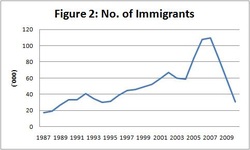|
The latest figures from the CSO suggest that the pattern of emigration from Ireland is continuing and is increasing in pace. Looking at Figure 1 it is clear that the decline in the number of people emigrating which occurred during the Celtic Tiger and the subsequent construction bubble has well and truly reversed itself. The level of emigration in 2010 was almost as high as it was in 1989, with an estimated 65,000 people leaving the State. The opposite pattern is occurring when immigration is occurring. The vast number of people entering Ireland during the economic boom has fallen off sharply. This has resulted due to changes in the jobs market. When employment was plentiful, there was an increase in the number of people entering Ireland, which filled the need in our labour market, However, as Figure 2 shows, as the market has contracted, less and less individuals are coming to Ireland. This has had a dramatic effect on our net emigration. This net figure is the number of people who are entering Ireland minus the number of people who are leaving. Historically, Ireland has suffered with net emigration, with more people choosing to emigrate as oppose to coming to Ireland. This is due to Ireland’s continuing failure to provide sufficient employment for its population. This trend was reversed in the boom years, with more people actually coming to Ireland than leaving. However, net migration has been falling since 2007, turning negative in 2009 and remaining negative in 2010. This is a sign of Ireland’s economic decline. Again, we are returned to a position where there is insufficient employment to meet the needs of the population, and as a result emigration is occurring.
0 Comments
Leave a Reply. |
AuthorJustin Doran is a Lecturer in Economics, in the Department of Economics, University College Cork, Ireland. Archives
December 2017
Categories
All
|



 RSS Feed
RSS Feed
